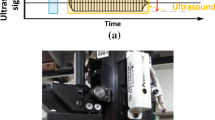Abstract
Copper wire bonding offers several mechanical and electrical advantages as well as cost saving compared to its gold wire predecessor. Despite these benefits, silicon cratering, which completes the fracture and removal of bond pad underlayers, has been a major hurdle to overcome in copper wire bonding. Copper wire is harder than gold, and thus needs greater ultrasonic power and bond force to bond it onto metal pads such as aluminum. This paper reports a study on the influence of wire materials, bond pad hardness, and bonding-machine parameters (i.e., ultrasonic power and bond force) on silicon cratering phenomenon. Ultrasonic power and z-axis bond force were identified as the most critical bonding machine parameters in silicon cratering defects. A combination of greater bond force and lower ultrasonic power avoids silicon cratering and gives the desired effects. Results also show that a harder bond pad provides relatively good protection from silicon cratering.
Similar content being viewed by others
References
S. Mori and H. Yoshida: “The Development of New Copper Ball Bonding-Wire,” Proc. of 38th IEEE Electronics Components Conference, New York, NY, 1988.
S.L. Khoury, D.J. Burkhard, D.P. Galloway, and T.A. Scharr: “A Comparison of Copper and Gold Wire Bonding on Integrated Circuit Devices,” IEEE Trans. Compon. Hybrids Manuf. Technol., 1990, 13(4), pp. 673–81.
K. Toyozawa, K. Fujita, S. Minamide, and T. Maeda: “Development of Copper Wire Bonding Application Technology,” IEEE Trans. Compon. Hybrids Manuf. Technol., 1990, 13(4), pp. 667–72.
L.T. Nguyen, D. McDonald, A.R. Danker, and P. Ng: “Optimization of Copper Wire Bonding on Al-Cu Metallization,” IEEE Trans. Compon. Hybrids Manuf. Technol. 1995, 18(2), pp. 423–29.
W.J. Tomlinson, R.V. Winkle, and L.A. Blackmore: “Effect of Heat Treatment on the Shear Strength and Fracture Modes of Copper Wire Thermosonic Ball Bonds to Al-1%Si Device Metallization,” IEEE Trans. Compon. Hybrids Manuf. Technol., 1990, 13(3), pp. 587–91.
G. Omar and C.-W. Tan: “Development of Copper Wire Bonding Technology,” ON Semiconductor 1st Manufacturing Technology Symposium, DBP Publisher, Malaysia, 1999.
G.G. Harman, Reliability and Yield Problems of Wire Bonding in Microelectronics—The Application of Materials and Interface Science, International Society for Hybrid Microelectronics, McGraw-Hill, New York, 1989.
H. Koyama, H. Shiozaki, I. Okumura, S. Mizugahsira, H. Higuchi, and T. Ajiki: “A New Bond Failure: Wire Cratering in Surface Mount Device,” Proc. of 26th International Reliability Physics Symposium, IEEE, New York, 1988.
G.V. Clatterbaugh and H.K. Charles: “The Effect of High Temperature Intermetallic Growth on Ball Shear-Induced Cratering,” IEEE Trans. Compon. Hybrids Manuf. Technol., 1990, 13(1), pp. 167–75.
G.G. Harman and K.O. Leedy: “An Experimental of the Microelectronic Ultrasonic Wire Bonding Mechanism,” 10th Annual Proc. Reliability Physics, 1972, pp. 49–56.
T. Kosh, W. Richling, and W. Whitlock: “A Bond Failure Mechanism,” 24th Annual Proc. Reliability Physics, IEEE, New Jersey, 1986, pp. 55–60.
W. Whitlock: Shimadzu Dynamic Ultra Micro Hardness Tester Model DUH-202 User’s Guide, 1997, Shimadzu Corp., Kyoto, Japan.
W.H. Lycette, E.R. Knight, and S.W. Hinch: “Thermosonic and Ultrasonic Wire Bonding to GaAs FETs,” Int. J. Hybrid Microelectron., 1982, 5, pp. 512–17.
Author information
Authors and Affiliations
Rights and permissions
About this article
Cite this article
Wei, T.C., Daud, A.R. Cratering on thermosonic copper wire ball bonding. J. of Materi Eng and Perform 11, 283–287 (2002). https://doi.org/10.1361/105994902770344088
Received:
Revised:
Published:
Issue Date:
DOI: https://doi.org/10.1361/105994902770344088



